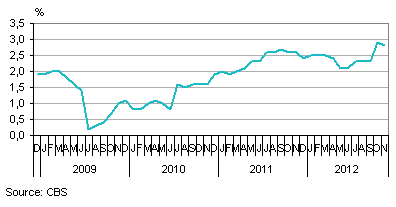Dutch inflation marginally down

The Dutch inflation rate was 2.8 percent in November. The rate in October was 2.9 percent, the highest over the last four years. Inflation is defined as the increase in the consumer price index (CPI) in a particular month compared to the same month in the previous year.
Motor fuel prices and phone fees had a downward effect on inflation, whereas prices of clothing and tobacco products had a slightly upward effect. On balance, inflation in November was marginally lower than in October.
The harmonised consumer price index (HICP) allows comparison between the inflation rates in the various member states of the European Union (EU). The level of inflation in the eurozone is one of the main guidelines for the European Central Bank (ECB) to change or refrain from changing the interest rate. According to the ECB, prices in the eurozone are stable, if the inflation rate is close to 2 percent.
According to the HICP method, the Dutch inflation rate was 3.2 percent in November, as against 3.3 percent in the previous month. Eurostat, the European statistical office, calculated an inflation rate of 2.2 percent for the eurozone, i.e. 0.3 percentage points down on October. The huge gap between inflation in the Netherlands and the eurozone can partly be attributed to the VAT increase from 19 to 21 percent introduced in the Netherlands on 1 October 2012.
Dutch inflation rate

More figures can be found in the Business cycle dossier.
For more information on Dutch inflation, see Statistics Netherlands’ online video on YouTube.
For more information on economic indicators, see the Economic Monitor.